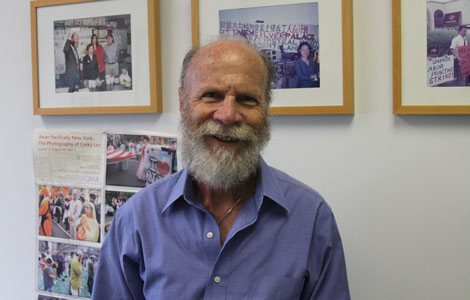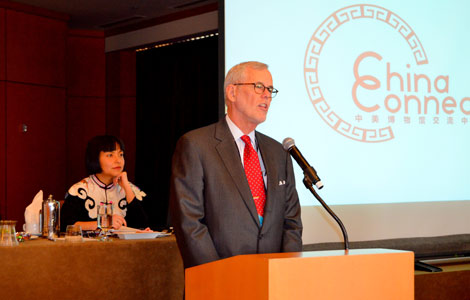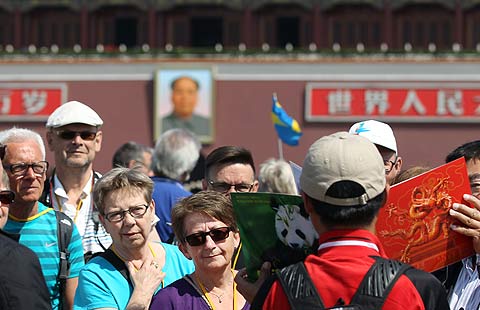Shanghai 'most popular city' for migrants
Updated: 2014-05-19 01:09
By WANG HONGYI in Shanghai (China Daily)
|
||||||||
 |
|
Tourists pose beside the bronze statue of a charging bull on the Bund in Shanghai early this month. [Photo by Yan Daming / For China Daily] |
Shanghai has become the country's most popular city for the floating population, a survey showed, but the accolade also renews concerns among residents over increased pressure on urban resources.
The city recorded a net inflow population of about 9.54 million while Beijing ranked second with about 7.72 million, the research showed. The southern boom city of Shenzhen ranked third, with a net inflow of 7.56 million people.
Shanghai's new ranking was based on research by Value Line, a Shanghai-based financial magazine.
"As the country's financial hub and an international metropolis, Shanghai undoubtedly has great appeal for those on the move. More and more people head to the city seeking more and better development opportunities," said Wen Jun, director of the Institute of Sociology at East China Normal University.
The establishment of the Shanghai Free Trade Zone will further boost the city's economic development, creating even more opportunities that will continue to fuel population growth, Wen said.
Another survey, released last month and based on more than 51,000 soon-to-graduate students from 103 universities across the country, showed that Shanghai is the top preference for employment after college.
"I choose to work in Shanghai upon graduation. In addition to more opportunities, the city has quality education resources, advanced medical services and highly civilized residents, which my hometown cannot compare with. So I hope I can settle down in the city with my family in the future," said a man surnamed Lu, who is from Hunan province and has lived in the city for six years.
Many migrants drawn to the large cities say they have obvious advantages beyond jobs, in various social resources such as cultural, healthcare, education and other public facilities.
Sociologists say migrants are also increasingly looking for ways to integrate with the local population and settle down in the cities.
But the explosive inflow of migrants has also renewed concerns among many residents, who worry that the effect has become increasingly acute in some extra large cities such as Beijing and Shanghai. These cities have in turn experienced high pressure on their land, environment, water resources and even social stability.
In Shanghai, medical resources per capita have lagged far behind those of other cities, though its number of large hospitals and registered medical staff rank as some of the highest in the country.
Official figures showed that the city's hospitals received about 214 million patient visits in one year, the highest in the country. More than 60 percent of patients in large hospitals are not registered Shanghai residents.
Beijing's public security authorities said about 70 percent of the crimes in the capital were committed by the migrant population.
In recent years, governors from these large cities have been looking for effective ways to better manage the floating population and promote the city's organic development.
To reduce the impact on social management by the increasing inflow of migrants, experts and scholars have suggested reducing the unlimited inflow of population and strengthening the development of mid-sized cities.
Plans for strictly controlling the population scale in extra-large cities and opening up middle and small cities were also laid out during the Third Plenum of the 18th Central Committee of the Communist Party of China in November.
The public services and high expectations of better opportunities in big cities have constantly attracted the migrant population. In contrast, middle- and small-sized cities have yet to offer such attractions.
The government should take effective measures to narrow the gap in different regions, especially between urban and rural areas, said Long Haibo, a researcher from the Development Research Center of the State Council.

 Chicago students prep for China trip
Chicago students prep for China trip
 Global music festival tunes up
Global music festival tunes up
 Chinatown garment workers awarded $1.2 million
Chinatown garment workers awarded $1.2 million
 President of AAM welcomes representatives from museums
President of AAM welcomes representatives from museums
 Yiwu manufacturers score big in lead up to soccer world cup
Yiwu manufacturers score big in lead up to soccer world cup
 Chinese folk dance shown in NYC parade
Chinese folk dance shown in NYC parade American Civil War re-enactment in Illinois
American Civil War re-enactment in Illinois
 Thousands of dancers attend annual dance parade in NYC
Thousands of dancers attend annual dance parade in NYC
Most Viewed
Editor's Picks

|

|

|

|

|

|
Today's Top News
Chinese investment bolsters EB-5 visa program
China, US boost military ties, general says
Republican 'establishment' squeezes Tea Party
1st responders visit Sept 11 Museum
Jumei IPO raises $245.1 million
Investors play it safe as doubt over economy rises
Obama marks anniversary of desegregation ruling
Arson suspect charged in California
US Weekly

|

|






